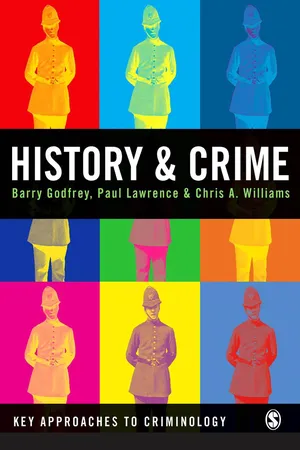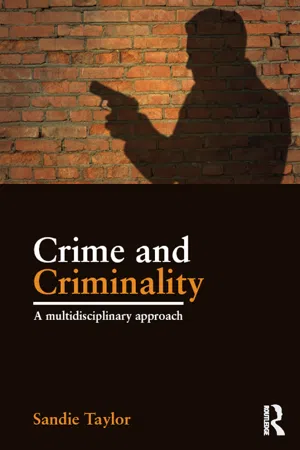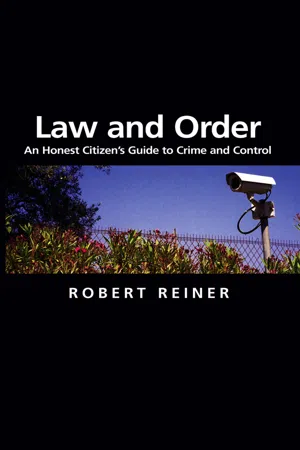Social Sciences
Police Crime Statistics
Police crime statistics refer to the data collected by law enforcement agencies on various criminal activities within a specific jurisdiction. These statistics provide valuable insights into the prevalence and trends of crime, aiding in the development of crime prevention strategies and resource allocation. They are often used by researchers, policymakers, and the public to understand and address crime issues.
Written by Perlego with AI-assistance
Related key terms
7 Key excerpts on "Police Crime Statistics"
- eBook - ePub
Criminal Justice
An Introduction
- Peter Joyce, Wendy Laverick(Authors)
- 2022(Publication Date)
- Routledge(Publisher)
It might thus be concluded that official crime statistics do not provide an objective statement relating to the amount of crime in society but are instead the product of a complex process of interplay between the main stakeholders of the criminal justice system – politicians, the media, criminal justice practitioners and the public. They reflect not the volume of crime in society but, rather, attitudes towards social behaviour which changes across historical time periods.The usefulness of crime statistics
The above discussion might suggest that police recorded crime statistics have little value to those wishing to study crime and deviance. This impression would not, however, be totally accurate, since these figures do convey useful information both to those who work within the criminal justice system and to those wishing to study its operations from outside. The information can be employed in two ways:- Crime pattern analysis. Crime reports form the basis of crime pattern analysis. This may be conducted locally or nationally, in connection with crimes that occur in different police force areas. A contemporary application of this is the mapping of crime using geographic information systems (GIS ) in order to identify trends and patterns of crime in order to prevent future occurrences and aid detection. GIS is an important component of a police management strategy known as Computer Statistics (or Comparative Statistics), termed CompStat.
- Omissions are revealing. Useful information regarding the operations and purpose of the criminal justice system may be gleaned from omissions in crime statistics. The under-reporting of certain types of crime such as sexual violence may provide valid information concerning victims’ perception of the operations of agencies within the criminal justice system and provide a rationale for their reform. Conversely, changes in the rates at which certain crimes are reported may evidence improvements to the working practices of key bodies that operate within the system. It has been concluded that statistical products of this kind may reveal more about changing attitudes and decision-making of those involved in the process than about changes in offending behaviour itself (Bottomley and Pease, 1986
- eBook - ePub
- Barry S Godfrey, Paul Lawrence, Chris A Williams(Authors)
- 2007(Publication Date)
- SAGE Publications Ltd(Publisher)
Almost always this is to point to a relatively crime- or violence-free past and contrast this to the present (Pearson, 1983; Hitchens, 2003). Another thing that many social commentators have done is to talk about ‘rates’ of crime. Whether they mention actual numbers or not, they are making claims about the total amount of crime: a measure that we can only arrive at through adding up lots of discrete incidents to produce a total. ‘Statistics’, defined as ‘the science of collecting and analysing numerical data’ (The Concise Oxford Dictionary), are what we end up with when we aggregate together large numbers of events. Naturally then, there is a constructed aspect to all statistics. However, for the last 200 years, statistics of all kinds have been a central element in the way that advanced societies are governed, and the way that political adjustments to that governance have been advocated and justified. Statistics tend to be taken to be scientific, independent and therefore accurate. This chapter will look at the ways that criminal statistics have been defined and used; both by contemporaries who published them and discussed them, and later by historians who have tried to see what conclusions can be drawn from them - eBook - ePub
Researching Crime and Justice
Tales from the Field
- Louise Westmarland(Author)
- 2013(Publication Date)
- Willan(Publisher)
Taking these types of research together (primary and secondary) this chapter begins with the more ‘public’ side of criminological research. It reflects the way statistics are used, studies that ‘count’ and the growing importance of evaluation in criminological research. One reason why these studies or data are considered public is that they are often considered ‘official’ statistics – that is, numbers of crimes or incidents collected by public bodies such as the police, prisons and courts, and made available (usually free of charge) to any researcher who wishes to access the data. In addition, they are often the studies from which conclusions are drawn that lead to government policies and, ultimately, new laws. In this sense this chapter is about the way statistics are used in quantitative studies, using some examples of existing and potential research projects.This chapter begins with some observations on the general nature of crime statistics, government figures on levels of different types of crime, police clear-up rates, and so on. It is these figures that are often referred to as the ‘official’ statistics of crime. There follows a discussion of the problems with this type of published research and the basic methods that are used to collect the statistics the government (and many others) use to base decisions about new legislation and policies. The collection of statistics that can contradict these ‘official’ criminal justice data are then discussed. The main source of these ‘critical’ statistics has traditionally been the British Crime Survey, the BCS. These are also collected by the government, in the sense that they are collected by a government-funded agency, and so it is slightly misleading to differentiate between the two. They way they provide a comparison with, or sometimes contradict, ‘official’ statistics is that they give a picture of what people say has happened to them rather than facts from organisations such as the police. This is explained in more detail below. Then the chapter moves into ‘non official’ statistics, and the principles guiding the collection and reliability of these figures which may become ‘facts’. Finally the work of the first interviewee in this volume is discussed, to illustrate the problems, pitfalls and potential solutions to problems of research using statistics. - eBook - ePub
Crime and Criminality
A multidisciplinary approach
- Sandie Taylor(Author)
- 2015(Publication Date)
- Routledge(Publisher)
Furthermore, police might disagree with a victim’s perception of the event and conclude that a crime had not occurred or is trivial (Hough and Mayhew 1985). A trivial event might be perceived by the police as an ineffective use of their police resources, and given that they have a finite budget, decisions of resource allocation are based on a system of priority and urgency. The Metropolitan Police, for example, introduced a point system to indicate solvability of certain crimes but was later abandoned. Instead a counting method where the number of offences committed or the number of offences involving more than one victim was used. Since counting methods varied considerably across many police forces, there has been a call for their standardisation. The Smith Review (see next section) in 2006 emphasised that the differences in police practice has led to variations of reporting, recording and counting rules adopted by different police forces throughout England and Wales. Uniformity of police recording methods therefore has been placed at the top of the agenda for standardised police practice. Crime statistics obtained from police records and information from the British Crime Survey (BCS) provide the HO with a useful indicator of the frequency and nature of crime occurring in Britain today. In the Police Crime Statistics serious and non-serious crimes are classified separately and there are further sub-categories of serious crime, which will be considered in the next section on crime classification.Classification of crime from statisticsIn the UK the two main sources of statistical crime data are derived from police recorded crime figures and the British Crime Survey (renamed as Crime Survey for England and Wales (CSEW) in 2012). In the US a system known as Uniform Crime Reports is adopted which has a strong degree of overlap in the way crime is classified and recorded in the UK. There is also the National Crime Victimization Survey which is similar to the CSEW in England and Wales. All four methods of collating crime data will be described, and the advantages and disadvantages of police recorded crime figures and data from the CSEW in England and Wales compared. - eBook - ePub
- Tim Newburn(Author)
- 2017(Publication Date)
- Routledge(Publisher)
Despite the warnings of criminologists and government statisticians alike, these statistics are still treated by many politicians and journalists as an accurate ‘barometer’ of crime, and any sizeable rise in the figures they produce tends to receive widespread publicity and spark off arguments about police or government ineffectiveness or the need for sentencing changes (falls, conversely, tend to be largely ignored). The figures are also used a great deal at a local level to inform the distribution of police resources and, increasingly, the preparation of crime ‘audits’ and crime reduction plans, as well as the measurement of police and crime reduction partnerships’ ‘performance’ in comparison with targets and other areas.Some limitations of Criminal StatisticsThe numbers of particular crimes, and the overall level of crime, recorded in Criminal Statistics , can be profoundly affected by changes in:- • decisions about which offences to include (only 'notifiable' offences are included; this excludes 'summary' offences, as well as those offences recorded by non-'Home Office police forces' such as the British Transport Police, the Ministry of Defence Police, etc.);
- • changes in the 'counting rules';
- • changes in public attitudes toward the reporting of particular offences;
- • changes in police practices toward particular offences (the 'upgrading' or 'downgrading' of particular offences).
In addition, Criminal Statistics are a poor tool for:- • understanding the social context of crime (very diverse crimes are included under broad offence headings);
- • understanding the relative risks of victimization.
Review questions- 1 When were official crime statistics first collected in Britain?
- 2 What is meant by ‘attrition’?
- 3 What are the main reasons people fail to report crimes to the police?
- 4 Why might the police decide to, or fail to, record crimes that are reported to them?
Victimisation surveys
The essence of the victimisation survey is the standard sample survey. The objective is generally to seek to interview a representative sample of a particular population and to ask them a series of questions about their experience of victimisation – usually over the past year. As with so many elements of modern social scientific inquiry, the victimisation survey began life in America. The product of President Johnson’s government in the 1960s, victimisation surveys were intended to provide a more accurate measure of the extent of crime, and of trends in crime, than the hitherto standard method of relying on official statistics – the Uniform Crime Reports. - eBook - ePub
Baden and the Modern State
The Implementation of Administrative and Legal Reforms in the German State of Baden during the 19th Century
- Felix Selgert(Author)
- 2018(Publication Date)
- De Gruyter Oldenbourg(Publisher)
Criminal statistics, scholars argued, could be biased towards specific delicts to which the courts paid special attention. Furthermore, criminal statistics were dependent on the rigor with which the police produced evidence that could be used before court. Instead, researchers started to favor those statistics that were closer to the reality, like statistics produced by the police including arrests and reported offences rather than convictions. 509 However, also these statistics can be biased towards specific delicts that were prosecuted more rigorously and dependent on the organization and the quality of the police forces. In England, for example, modern police forces were established in waves on county-level, starting with the Metropolitan Police in London in 1829 and ending in 1856. 510 Increasing crime rates during this time may thus be a result of the delayed professionalization of police forces. Likewise, Rainer Blasius argues that rising crime rates during the nineteenth century were the result of the expansion of police forces and local courts. 511 Registered crime was and still is furthermore dependent on the official definition of what constitutes a crime or an offence. These rules are codified in the penal code and administrative regulations. Over time, these definitions may change. In Baden, for example, the penal code was reformed in 1852. Crime registered by the police or the courts furthermore depends on the population’s cooperation with the administration. A change in the propensity to report a specific crime may thus also affect the change of registered crime over time. Although the overall propensity of reporting a crime may have only changed slowly during the nineteenth century, there seem to be differences in the reporting behavior between cities and rural areas. 512 According to Zehr, villagers rated theft as a very serious and therefore reportable crime while minor assaults were solved within the commune - eBook - ePub
Law and Order
An Honest Citizen's Guide to Crime and Control
- Robert Reiner(Author)
- 2013(Publication Date)
- Polity(Publisher)
Since then the annual volume Crime in England and Wales provides data on the overall extent of crime from both sources, on victim reporting and police recording, the pattern of crime by offence and by region, recent trends, and the detection or ‘clear up’ rate. 3 Problems of Interpreting Police Recorded Crime Statistics Criminologists and statisticians have long been aware that the official crime statistics suffer from many pitfalls which make their interpretation hazardous. 4 Nonetheless, popular newspapers continue to present the police recorded statistics as if they were straightforward and unequivocal measures of crime. 5 What the tabloids unabashedly call the ‘crime rate’ the Home Office more cautiously labels ‘Crimes recorded by the police’. If this was taken literally, there would be no problems: by definition the number of crimes recorded by the police is the number of crimes recorded by the police! It is a long time since any official sources referred to this as the ‘crime rate’, 6 and appropriate health warnings abound in current Home Office publications. But the basic issue remains: how accurately do the figures recorded by the police reflect rates and patterns of crime? The ‘dark figure’ As has long been recognized, the police recorded statistics are problematic because of the so-called ‘dark figure’ of unrecorded crime. In a well-worn metaphor, the recorded rate represents only the tip of the iceberg of criminal activity (and a fortiori culpable harm). At issue is what we can learn about the totality from the part that is visible. There is much evidence that the police statistics are ‘supplyside’ driven, reflecting the changing exigencies of Home Office policy-makers and police bureaucracies as much as the activities of offenders and victims. 7 If we could be confident that the recorded rate was representative of the rest it would at least be a reliable guide to trends and patterns
Learn about this page
Index pages curate the most relevant extracts from our library of academic textbooks. They’ve been created using an in-house natural language model (NLM), each adding context and meaning to key research topics.






